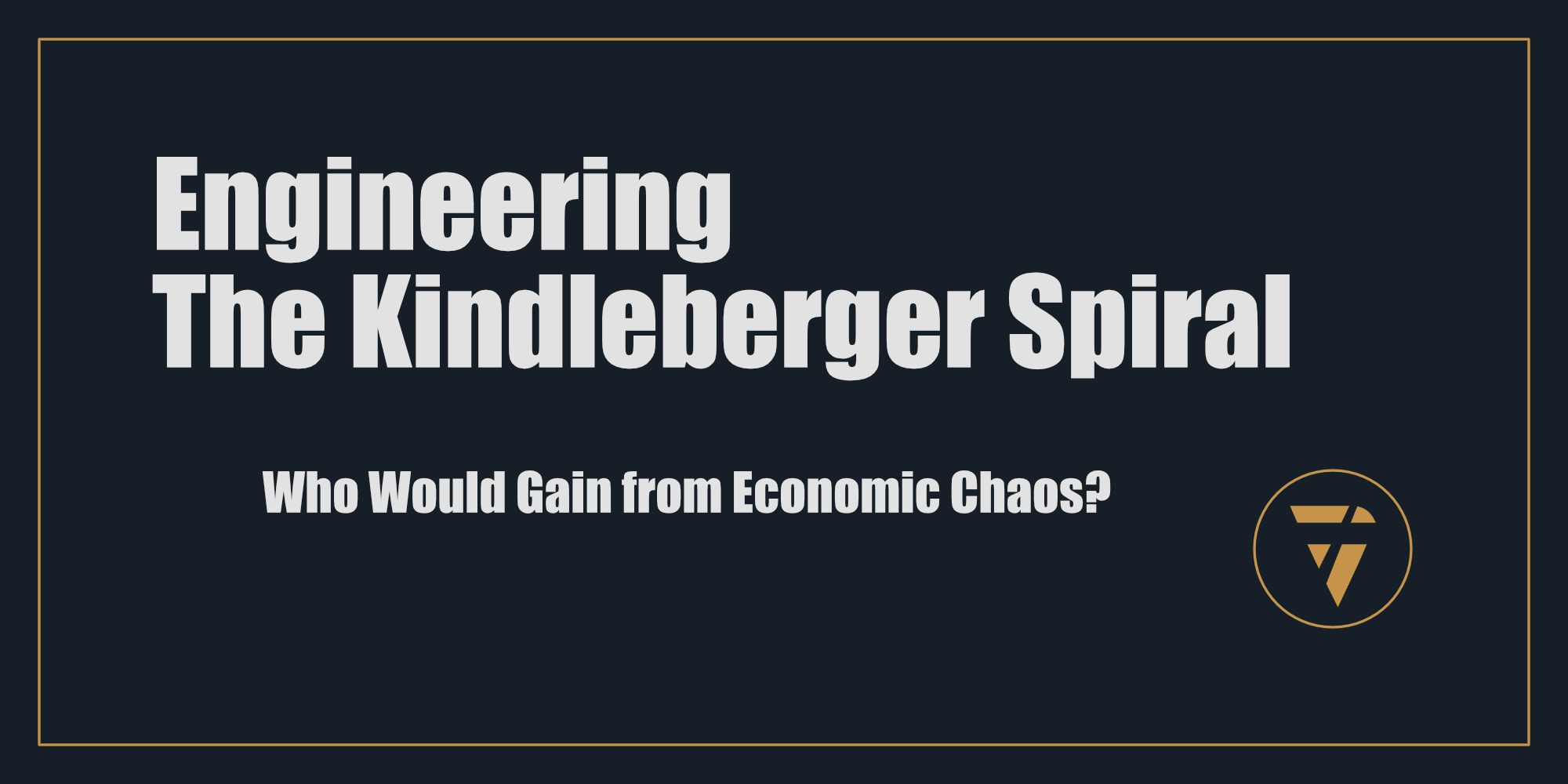Engineering the Kindleberger Spiral

Who Would Gain from Economic Chaos?
This is the power of controlled collapse.
The Kindleberger Spiral is a phenomenon of economic self-destruction, a sequence of financial panic, policy failure, and retaliatory protectionism that spirals into global collapse. Historically, it emerged from a combination of bad decisions, panic, and unintended consequences.
But what if it weren’t an accident?
What if a powerful entity deliberately initiated and manipulated such a spiral to serve its own strategic goals?
In today’s highly inter-connected and data-driven financial world, such a scenario is not only feasible—it is potentially highly profitable and geopolitically advantageous for the right players. The idea of an engineered Kindleberger Spiral raises an urgent question:
Who Would Benefit from Economic Devastation?
The answer is both unsettling and deeply revealing about the nature of power, finance, and global control.
1. The Players: Who Would Engineer the Collapse?
A controlled Kindleberger Spiral would require an entity with enough influence to destabilize global markets while simultaneously positioning itself to profit from the destruction. The most likely actors include:
A. Hedge Funds & Financial Speculators
- The best time to make money in finance isn’t when the market is strong—it’s when the market is collapsing, and you know it’s coming.
- Short-selling (betting against assets) allows institutions to profit enormously from market downturns.
- If a major hedge fund or institutional investor could predict (or instigate) protectionist policies, credit freezes, or financial panic, it could execute massive short positions across stocks, currencies, and commodities.
Gain: Trillions in profit from short positions on stocks, currencies, and government bonds.
B. Central Banks & Governments Seeking Monetary Leverage
- If a global economic collapse were triggered, central banks would be forced to intervene.
- Those controlling the dominant reserve currencies (USD, EUR, CNY) could leverage crisis to force weaker economies into dependence—providing loans and bailouts in exchange for policy control.
- Countries like the U.S. or China could intentionally fuel a financial spiral to break the economies of their rivals and expand their own economic reach.
Gain: Strategic financial dominance over weaker nations, currency control, and policy influence over indebted governments.
C. Corporations Positioning for Market Domination
- In a major economic downturn, weaker companies fail. The survivors buy their competitors for pennies on the dollar.
- A monopoly-minded corporation could back policies that restrict global trade, knowing that the ensuing collapse would allow it to consolidate power over its industry.
- Consider Big Tech, Pharma, or Energy giants—if a depression wipes out their competition, they can rebuild the industry on their terms.
Gain: Industry dominance by acquiring distressed competitors, lobbying power, and market consolidation.
D. Geopolitical Strategists & War Economies
- If a major economic collapse weakens key rival nations, it sets the stage for geopolitical shifts, military expansion, and strategic takeovers.
- Historically, war often follows economic devastation—and war is an industry.
- A country seeking to reassert global dominance (China, Russia, the U.S.) might see a manipulated economic spiral as a precursor to military or political restructuring.
Gain: Control over weakened nations, justification for military action, new resource access.
2. The Methods: How Would Someone Deliberately Create the Spiral?
To engineer a Kindleberger Spiral, the manipulator must orchestrate key economic triggers in a specific sequence. These would include:
A. Spark Financial Panic (Stage 1: Market Shock)
- Initiate a market downturn through aggressive short-selling and fear-based narratives.
- Leverage social media, news outlets, and AI-driven market manipulation to amplify panic.
- Example: The 2008 Financial Crisis was fueled by engineered speculation in mortgage-backed securities. A repeat scenario could be manufactured in bond markets, crypto, or AI-driven trading systems.
Outcome: Market instability creates the conditions for protectionist policies and banking crises.
B. Push Governments Toward Protectionism (Stage 2: Policy Failure)
- Lobby for tariffs, trade restrictions, and economic nationalism under the guise of "protecting domestic industry."
- Encourage leaders to retaliate against manufactured economic threats, isolating key economies.
- Example: The Smoot-Hawley Tariff of 1930 triggered a 66% collapse in U.S. trade—imagine an AI-driven, globally co-ordinated version of this today.
Outcome: Global trade slows, businesses fail, and economic polarization increases.
C. Create Banking Crises & Debt Traps (Stage 3: Credit Freeze)
- Withdraw capital from key economies, triggering banking collapses.
- Use interest rate manipulation to create an artificial liquidity crisis (where companies and individuals suddenly cannot access credit).
- Example: The 1931 European banking collapse accelerated the Great Depression.
Outcome: Banks fail, businesses close, and unemployment spikes.
D. Capitalize on the Crash (Stage 4: Asset Seizure & Market Takeover)
- The controlling entity, having anticipated the collapse, now moves in to "rescue" strategic assets.
- Distressed industries (real estate, tech, energy) are acquired for pennies on the dollar.
- Bailouts and government intervention solidify the dominance of the few over the many.
Outcome: The mastermind of the spiral emerges with unprecedented control over financial markets, industries, and nations.
3. The Payoff: What Would Be Gained by Controlling a Kindleberger Spiral?
If a group successfully engineered this economic collapse, their return on investment would be astronomical.
- Trillions in financial market profits from short-selling.
- Monopoly control over industries by acquiring distressed competitors.
- Geopolitical dominance by weakening rival nations.
- Complete control over financial policy, forcing governments to accept their terms.
In short: they would own the future.
4. The Countermove: How to Prevent Economic Manipulation
The only way to prevent an engineered Kindleberger Spiral is to recognize the warning signs and counteract manipulation before it takes hold.
Recognize False Narratives: Financial panic is often media-driven. Be critical of fear-based economic reporting.
Prevent Protectionism: Governments must resist pressure to escalate trade wars and restrict financial flows.
Control AI-Driven Market Manipulation: Modern financial collapses are algorithmic. Regulators must watch for AI-driven volatility.
Strengthen Global Cooperation: The Kindleberger Spiral thrives on fragmentation. The only real counter-strategy is collective economic resilience.
The Dark Side of Economic Warfare
A Kindleberger Spiral does not have to be an accident. With today’s financial instruments, digital media control, and AI-driven speculation, it can be engineered—to catastrophic effect.
The key question is not just who benefits from collapse, but rather: Are we already watching it happen?
Because if we are, the time to act is before the spiral completes.
This is what I’m working on. Tell me what you think, I enjoy the conversation! Subscribe and follow the work in real time.
Thanks!
B

A collapsing economy isn’t just a disaster—it’s an opportunity for those who pull the strings. The Kindleberger Spiral can be engineered for power, profit, and control. Who benefits when markets burn? Those who lit the match. Watch the signs. Move before the spiral completes.
PS -






